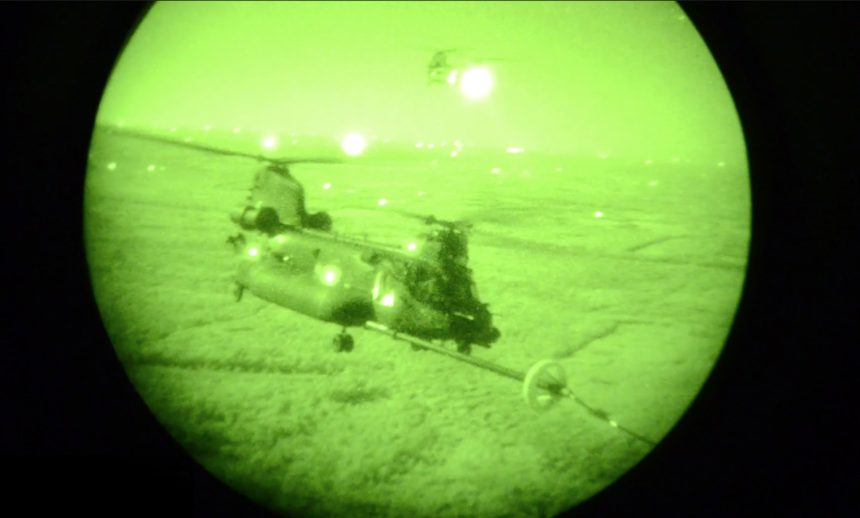Night HAAR (Helicopter Air-to-Air Refueling) is one of the key capabilities of the elite U.S. Army 160th Special Operations Aviation Regiment.
The 160th SOAR is a highly-specialized combat aviation unit headquartered at Ft. Campbell, Kentucky that supports elite U.S. and coalition combat units like Army Special Forces, Naval Special Warfare (SEALs) and other special operations units. 160th SOAR mainly operate at night (hence their name) in attack, assault, reconnaissance, infiltration and exfiltration, and any kind of known or unknown special operations you may imagine. Indeed, the “Night Stalkers” are quite famous for the raid to capture Osama bin Laden, Operation Neptune’s Spear, on May 1, 2011. During that raid, the unit flew a classified, low-observable variant of the Blackhawk helicopter that has since been popularly referred to in speculation as the “MH-X Stealth Black Hawk” or “Silent Hawk”. Images of part of the secret helicopter were seen around the world when one of them crashed inside Bin Laden’s compound during the raid, leaving the tail section visible. Books and media accounts suggest only two of the aircraft were ever produced.
During the years we have also speculated about the existence of stealthy Little Birds and stealthy Chinooks as well, but what is certain is that the U.S. Army’s elite team fly MH-47G Chinooks, MH-60L/M/K Black Hawks and A/MH-6M Little Birds. Since Nov. 19, 2013, the Night Stalkers also operate the MQ-1C Gray Eagle drone, an advanced derivative of the Predator specialized in providing direct operation control by Army field commanders, used to carry out Reconnaissance, Surveillance, and Target Acquisition (RSTA); convoy protection; Improvised Explosive Device (IED) detection as well as able to providing live aerial imagery to ground patrols and to carry PGMs (Precision Guided Munitions).
Here’s what we wrote about the unit when we published some rare images of the Night Stalkers training in plain daylight close to the Dam Neck Annex of Oceana Naval Air Station, Virginia.
The U.S. Army’s 160th SOAR specializes in night flying at low altitude for clandestine insertions into denied areas. Aircraft flown by the Nightstalkers have an exotic communications and sensor suite on board accounting for the massive number of antennae and vision systems protruding from the helicopters. The MH-60M Blackhawks have a dazzling array of special secure radios, sensors and satellite communications on board. They include the AN/ARC-201D single channel ground and airborne radio system (SINCGARS), four onboard Raytheon AN/ARC-231 Skyfire radios, two of them equipped with satellite communications capability, two AN/ARC-220 high frequency radios, an MTX Blue Force Tracker to prevent accidental friendly fire engagements. The nose of the MH-60M also features the Raytheon AN/APQ-187 SilentKnight radar for terrain-following at low altitude at night and the Raytheon AN/ZSQ-2 EOSS electro-optical (EO) and infrared (FLIR) cameras for night vision. Nightstalker pilots are also the most proficient aviators in the world at dangerous low-altitude, night vision goggle flying.
One of the key features of the Night Stalkers choppers is their ability to be refueled mid-air in the darkness of night: this is particularly important to perform medium to long-range clandestine missions into denied areas. For this reason they regularly train with the support of various U.S. Air Force units flying different variants of the C-130H/J aircraft.
A video, recently disclosed by the U.S. DoD, shows the Night Stalkers train with their Chinook and Black Hawk helicopters during night plugs into the hose of a 920th Rescue Wing’s HC-130N Combat King. Noteworthy, the 920th Rescue Wing, based at Patrick Air Force Base, Florida, is the last Air Force unit that still flies the legacy HC-130P/Ns, that will be replaced by the first HC-130J Combat King II aircraft in March 2020.
It’s short but cool, enjoy!









